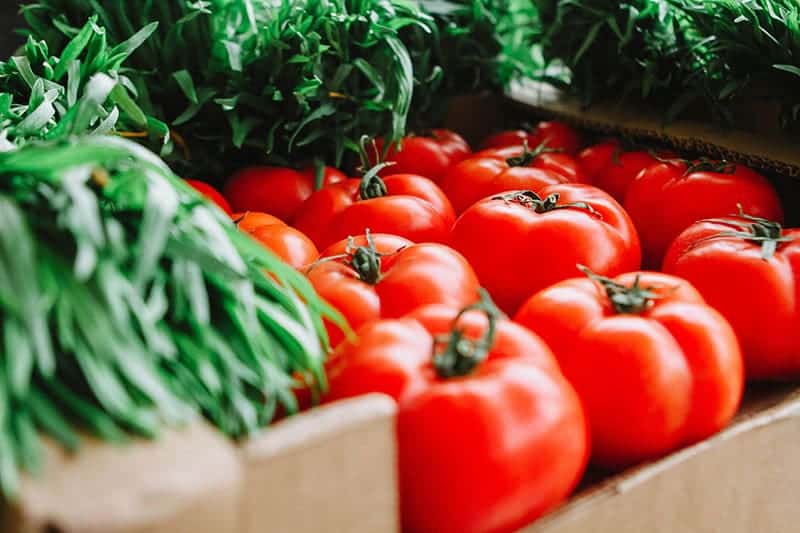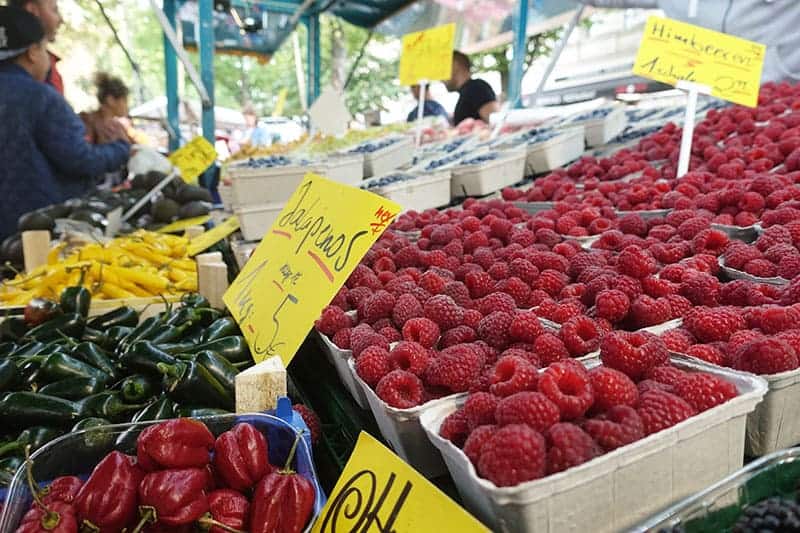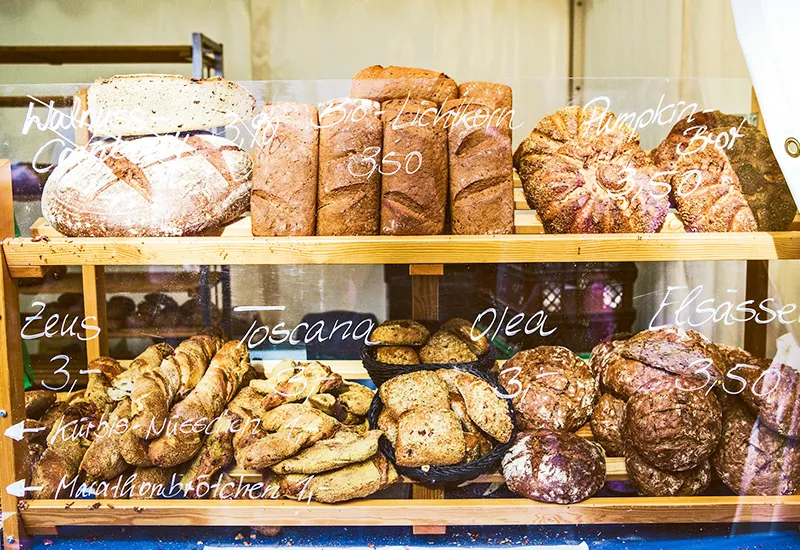You finally want to shop more regionally but don't really know how to get started? Then you've come to the right place! Whether it's apples from New Zealand or tomatoes from Spain: Nowadays, a lot of food is produced in faraway countries using a lot of energy, water and pesticides and then exported to Germany. And yet apples, tomatoes and many other foods grow locally.
Locality also plays a decisive role beyond food - for example in furniture, fashion, cosmetic products, garden plants, building materials and craftsmanship.
By consciously consuming regional products, each and every one of us ultimately has the opportunity to Make everyday life much more sustainable and at the same time promote your health and your own living environment.
In this article, I would therefore like to show you what regional shopping means, the benefits and positive consequences it brings and how you can easily implement regional consumption in your everyday life. Let's go!
Here you can find a short overview in advance:
Tip: By the way, I have written a separate article about seasonal shopping if you miss this aspect. The focus here is now on regionality.
Definition: What does regional shopping mean?

Basically, a regional purchase refers to the Purchase of goods that are produced and also consumed in the same region. Regionality refers to the entire value chain and not just individual intermediate steps.
However, the term "regional" is not legally protectedwhich is why many manufacturers unfortunately simply define it a little more broadly and use it to print their product labels.
For me personally, for example, products are considered regional if they were produced within a maximum radius of 50 kilometers. Products from Germany are therefore not automatically regional. The focus is rather on the exact region within Germany in which it was produced.
Difference from a local purchase
The terms "regional" and "local" mean similar things, but they differ. Regional purchasing always refers to a large areain which the respective goods were produced. Locality is even more precise and describes a smaller geographical areafor example, a specific city in a region.
However, as everyone has a different starting point for evaluating regionality or locality, opinions differ accordingly. Whether regional, local or both: In the end, your conscious consumer behavior brings similar benefits.
Advantages: What are the advantages of regional consumption?

Before we get straight to the specific tips for regional shopping, I would like to show you, what speaks for the consumption of regional products and Why more and more people want to shop locally more often. I'm also wondering whether there are any disadvantages.
Personally, I am also motivated by the following reasons:
- High quality: Regional producers are under a certain amount of pressure to provide high quality due to their local focus. After all, those who offer poor quality products fall into disrepute regionally and jeopardize the success of their business.
- Environmentally friendly production: The production of regional goods (e.g. in heated greenhouses) emits significantly fewer climate-damaging greenhouse gases into the atmosphere. Water and energy consumption are also generally lower.
- Shorter transport distances: Many foodstuffs are transported to Germany by ocean-going vessels, trains, trucks and airplanes. Regional purchasing minimizes these transport routes or even makes them superfluous in some cases.
- Healthy food: Regional produce is not automatically healthy, but it is very likely to be healthier than conventional food. This is because most regional producers prefer a organic farming without the use of chemicals.
- Better taste: If you go regional when it comes to food, you get real delicacies! Fruit and vegetables get their unique flavor mainly because they can ripen in the fields and the harvest doesn't come too early.
- Strengthening the regional economy: By buying locally, you are automatically helping to strengthen the local economy in your region. This creates jobs and increases opportunities for everyone in the area.
Does regional purchasing also have disadvantages?
It's not so easy to find real problems or challenges here. Many people find it too strenuous to really always focus on regionality. But apart from the fact that this doesn't always have to be the case, the ecological, health and social benefits clearly outweigh the disadvantages.
Even the seemingly high Time required is a potential disruptive factor. To begin with, you really need to do some research to find out how you can consume as regionally as possible. But with this article, you're already well on your way. And once you've learned, you'll know and be able to do it. 🙂
Regional products are sometimes a little more expensive. This is due, for example, to the organic production methods, but often also to the fact that the products do not come from industrial mass production. However, apart from the fact that regionality does not automatically mean quality, regular joint orders from local farms, for example, offer a good opportunity to save money sustainably.
Fortunately, there are signs of clear trend in our society from. More and more people in Germany want to know where their products come from before they buy them.
10 tips: How do you manage to shop more regionally?

Whether Climate Change, Air Pollution, Water Shortage or illegal logging: Your regional consumption counteracts so many problems. The World Hunger! For example, there are no fish exports from countries in Southeast Asia, where many people live mainly on fish.
So how can each of us make regional shopping as easy and sustainable as possible in our everyday lives? I have listed some tips for you here!
1. shopping at the weekly market
The nice thing about weekly markets is that they are in almost every town and also in many villages there. A particularly large number of regional suppliers sell their food and other goods there - usually even unpackaged and in the spirit of the Zero Waste Lifestyle.
Grab one Basket or backpack (my absolute recommendation*) and off you go!
We go about to the market once a weekto buy all the food for the meals we have planned for the coming week.
Good to know: Keep in mind that there will of course also be a number of supra-regional suppliers with stalls selling products that are neither "regional" in Germany nor in your region.
2. community-supported agriculture (SoLaWi)
In SoLaWi, a group of consumers always cooperates with a food producer. If you belong to a community-supported agriculture group, then you can Influencing production and regularly receive healthy, regional and organically produced food.
In return, you pay the farmer the costs of production and, together with your consumer group, give him or her a Acceptance guarantee for its food. At the Netzwerk Solidarische Landwirtschaft e.V. for example, you can find more information about this!
3. use "anyway paths"
Local alternatives are usually not to be found in one place alone. Therefore use Routes that you travel regularly anywayto shop regionally. This saves time, energy and unnecessary journeys.
For example, you can make your purchase on the way home from workthe trip to the gym or the Collecting the children from the KiTa do. So reduce your CO2 emissions in everyday life and at the same time supports local providers without additional effort.
4. buy directly from the farm
Of course, everyone also has the opportunity to get food directly from the producers. The farms, most of which are organic, are of course particularly pleased about this, as their own commitment is also Economically more lucrative can be.
With a sustainable search engine why don't you just go on the search for a Farm sales near you and ask whether it is possible to have groceries delivered to your home on a regular basis. If so, you can form a community with your neighbors and order groceries once a week. This way, the (short) transportation route is even more environmentally friendly.
5. prefer food that is grown in Germany
Avoid or reduce the consumption of products that could not grow in Germany without energy-intensive facilities. Bananas, coffee, chocolate and avocados are never regionalunless you live in warmer climates, such as Brazil, Colombia or Indonesia.
Of course, this doesn't mean that you have to give up delicious chocolate forever and ever. However, it is important to understandthat it cannot be regional.
This insight will help you to adapt your own consumer behavior and, for example, to consciously Spreewald gherkins from Brandenburg, the Hessian potato "Sieglinde" or Bavarian beer to be preferred.
6. pay attention to organic products
The "organic" label does mean not automaticallythat it is a food that has been produced regionally. However, goods with an organic label at least give you an important indication of regionally produced products. Ideally, your shopping basket should contain food that is produced both regionally and organically.
7. buy regionally online
You can also use the Internet, for example Market gushers.com to buy regional, fair and organically produced food and to get to know the producers personally. Provider:inside post their weekly offers there and you can order them online, pay for them and pick them up at one of the local Marktschwärmereien.
In this way, producers sell regional products directly to you as the end consumer:in. In this way, you also ultimately support the companies that produce their food ecologically and fairly in your area.
8. use the seal as a safeguard
The trend is towards regional offerings. Of course, manufacturers and retailers have also recognized this. For their own profits unprotected terms such as "from the region", "from here" or "local" unjustifiably printed on the labels of food that has traveled hundreds or even thousands of kilometers.
For a truly regional purchase, you should simply keep this in mind and, to be on the safe side, check the trustworthy product seal pay attention.
A well-known seal for regionality is, for example, the Regional window. It provides information about the Place of manufacture and origin of the agricultural ingredients used.
The sticker with the squirrel from BuyLocal.com on products or the entrance doors of stores shows you not only food, but also also clothing or booksellersthat offer regional goods.
9. buy regionally at the supermarket
Some of the classic supermarkets, such as Tegut, Rewe and Edeka deliberately advertise regional products. In fact, in my experience, you can find them much more easily here than in discount stores like Aldi or Lidl.
In the supermarket, you should also pay attention to the Regionality seal pay attention. If a particular foodstuff has several ingredients, it may be labeled as regional even though only part of the product was produced regionally. It is therefore important to take a closer look or ask once.
Notice: The plastic free shopping of regional products is made possible by the many unnecessary plastic packaging a little more difficult, of course. But it is certainly possible!
10. gradually switch to certain regional product groups

A complete changeover can be overwhelming. Rather proceed step by step and design one everyday product after another in a more regional way. For example, start with the apples and tomatoes mentioned above or with pasta products such as bread.
As soon as it becomes routineyou can start looking for regional alternatives for other products. This will increase your commitment to regional and therefore sustainable consumption continuous.
Shopping regionally? It's not difficult!
Anyone looking into regional purchasing for the first time might be a little worried that the expense is getting out of hand. But in fact, it's just the entertaining changeoverwhich can be challenging.
After you have Tips and tricks internalized everything works (almost) by itself. Provided you don't change your living environment every month 🙂
"Supporting local businesses is the most direct way to make a positive impact on your community."
Zooey Deschanel, US-American actress
Do you have any questions, tips, or your own experiences with regional shopping that you'd like to share? Then feel free to leave me a comment below this post.
Stay sustainable,

PS: If the majority of your food ends up in the garbage can, regionality doesn't contribute to sustainability either. So read the article about the Reduction of food waste inspire something else.









nice detailed article. At smaller markets you have the opportunity to meet the farmer and producer of trust from the region directly. But of course you can never be sure where some products come from.
Hello Christoph, do you already know naveso.de - the new search engine for regional products? Marcus and I have created the site in our spare time and are live since this summer. Maybe interesting for you and your readers? Many greetings Lothar
Hello Lothar! Thanks for the tip, look at your project closely.
Best regards
Christoph
Comments are closed.